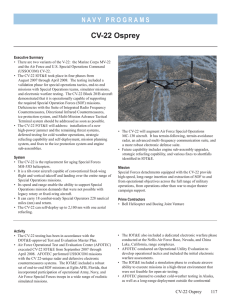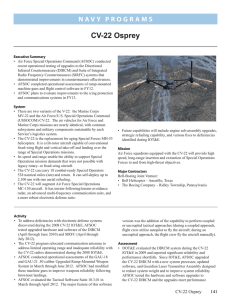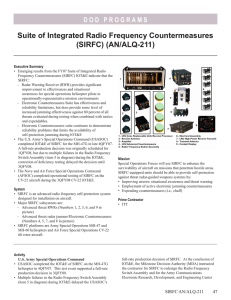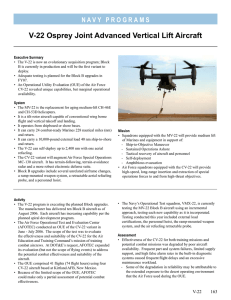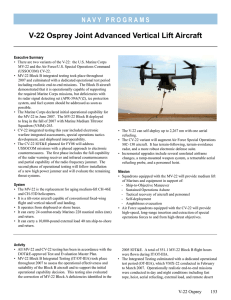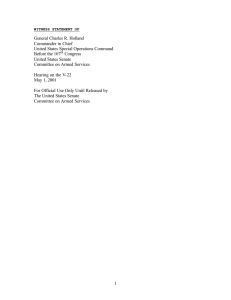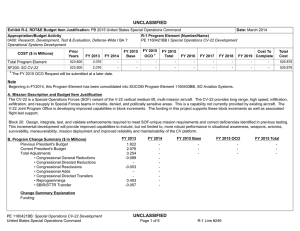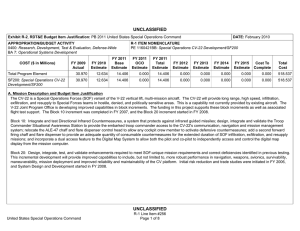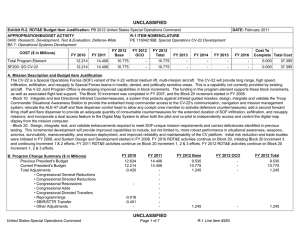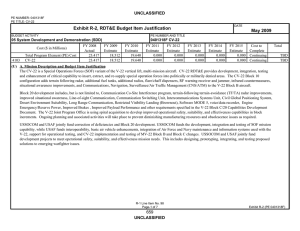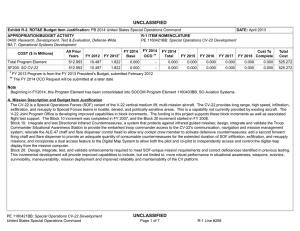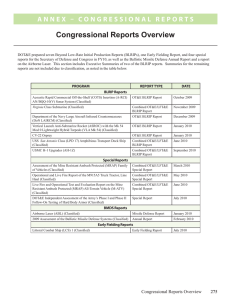CV-22 Osprey
advertisement
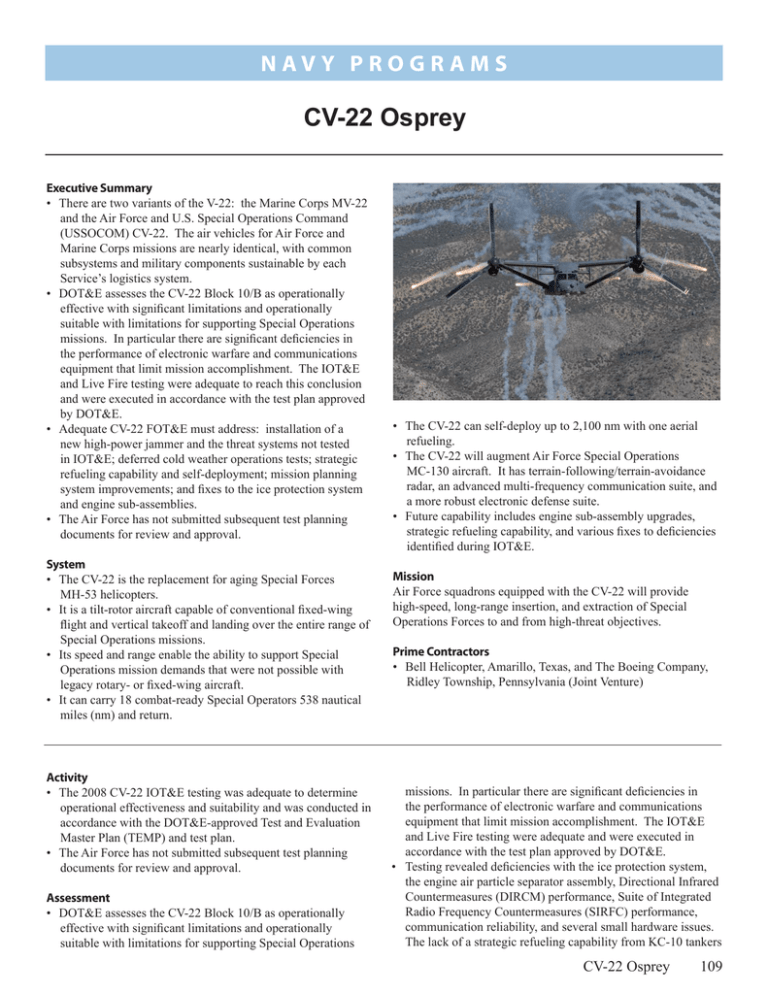
N a v y P ROGRA M S CV-22 Osprey Executive Summary • There are two variants of the V-22: the Marine Corps MV-22 and the Air Force and U.S. Special Operations Command (USSOCOM) CV-22. The air vehicles for Air Force and Marine Corps missions are nearly identical, with common subsystems and military components sustainable by each Service’s logistics system. • DOT&E assesses the CV-22 Block 10/B as operationally effective with significant limitations and operationally suitable with limitations for supporting Special Operations missions. In particular there are significant deficiencies in the performance of electronic warfare and communications equipment that limit mission accomplishment. The IOT&E and Live Fire testing were adequate to reach this conclusion and were executed in accordance with the test plan approved by DOT&E. • Adequate CV-22 FOT&E must address: installation of a new high-power jammer and the threat systems not tested in IOT&E; deferred cold weather operations tests; strategic refueling capability and self-deployment; mission planning system improvements; and fixes to the ice protection system and engine sub-assemblies. • The Air Force has not submitted subsequent test planning documents for review and approval. System • The CV-22 is the replacement for aging Special Forces MH-53 helicopters. • It is a tilt-rotor aircraft capable of conventional fixed-wing flight and vertical takeoff and landing over the entire range of Special Operations missions. • Its speed and range enable the ability to support Special Operations mission demands that were not possible with legacy rotary- or fixed-wing aircraft. • It can carry 18 combat-ready Special Operators 538 nautical miles (nm) and return. Activity • The 2008 CV-22 IOT&E testing was adequate to determine operational effectiveness and suitability and was conducted in accordance with the DOT&E-approved Test and Evaluation Master Plan (TEMP) and test plan. • The Air Force has not submitted subsequent test planning documents for review and approval. Assessment • DOT&E assesses the CV-22 Block 10/B as operationally effective with significant limitations and operationally suitable with limitations for supporting Special Operations • The CV-22 can self-deploy up to 2,100 nm with one aerial refueling. • The CV-22 will augment Air Force Special Operations MC-130 aircraft. It has terrain-following/terrain-avoidance radar, an advanced multi-frequency communication suite, and a more robust electronic defense suite. • Future capability includes engine sub-assembly upgrades, strategic refueling capability, and various fixes to deficiencies identified during IOT&E. Mission Air Force squadrons equipped with the CV-22 will provide high‑speed, long-range insertion, and extraction of Special Operations Forces to and from high-threat objectives. Prime Contractors • Bell Helicopter, Amarillo, Texas, and The Boeing Company, Ridley Township, Pennsylvania (Joint Venture) missions. In particular there are significant deficiencies in the performance of electronic warfare and communications equipment that limit mission accomplishment. The IOT&E and Live Fire testing were adequate and were executed in accordance with the test plan approved by DOT&E. • Testing revealed deficiencies with the ice protection system, the engine air particle separator assembly, Directional Infrared Countermeasures (DIRCM) performance, Suite of Integrated Radio Frequency Countermeasures (SIRFC) performance, communication reliability, and several small hardware issues. The lack of a strategic refueling capability from KC-10 tankers CV-22 Osprey 109 N a v y P ROGRA M S necessitates operational support from limited MC-130/KC-130 aircraft limit mission effectiveness. • Air Force Operational Test and Evaluation Center (AFOTEC) had planned to conduct cold-weather testing in Alaska, as well as a long-range deployment outside the continental United States during IOT&E, but these tests were deferred. No planning or execution of follow-on testing of critical shortfalls identified in IOT&E, deferred capabilities that were not included in previous testing, or new mission enhancements are in active planning by AFOTEC. • The currently approved TEMP FOT&E strategy assigns AFOTEC primary responsibility for planning and executing FOT&E. Contrary to that TEMP, AFOTEC has deferred FOT&E responsibility to Air Force Special Operations Command (AFSOC). AFSOC has assumed responsibility for follow-on testing, but they have not coordinated any ongoing test activity, resources for future testing, or scheduling of assets to adequately resolve the outstanding issues. Recommendations • Status of Previous Recommendations. The program addressed all but one of the previous recommendations. The 110 CV-22 Osprey recommendation regarding development of battle damage repair procedures and fire suppression systems for the aircraft dry bay remains valid. • FY09 Recommendations. 1. The Navy and Air Force should increase emphasis on correcting known deficiencies of the CV-22. 2. The Air Force should: ▪ Ensure that AFOTEC resumes responsibility for FOT&E of the CV-22. ▪ Ensure that the CV-22 defensive suite problems are fully corrected and operationally tested before the aircraft reaches Full Operational Capability. ▪ Demonstrate cold weather operational capability. ▪ Address deficiencies documented in IOT&E with the ice protection system, the multi-mission advanced tactical terminal, and the strategic refueling capability and operational test fixes.
